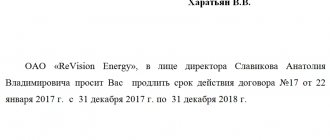What is MPI and is it necessary to verify electricity meters by law?
Inter-verification period (ICP) is a period of time after which the consumer needs to check the electric meter. If this requirement is ignored, the IPU goes into the “non-working” category, and the readings transmitted from it cannot be accepted for settlement transactions.
Each type of device has a separate interval within which the information is recognized by the power supply organization as relevant. With regard to resource consumption, verification in apartment buildings and private households, it is necessary to rely on the following regulations - federal laws No. 102 and No. 261.
However, from June 1, 2020, premises owners are exempt from the need to:
- use IPU;
- transmit information about metering devices when they fail;
- install equipment.
Due to its malfunction or the end of the inter-verification period, the RSO or service company is obliged to restore the resource supply by installing a new device.
Watch the video: “What to do if the verification period for the electric meter has expired. How to avoid fines."
Who should carry out scheduled verification
Verification of electricity meters without removal is carried out by special enterprises:
- State The metrological institution is authorized to carry out diagnostics of all types of meters.
- Private companies analyze and evaluate the electricity consumption monitoring device subject to certification. A license can be requested before concluding a contract. The document is issued by the Federal Service.
- Organizations serving an apartment building, if there is a certificate of admission to these types of services.
When a citizen applies for diagnostics to a non-state enterprise, it is necessary to check the accreditation certificate for expiration date. Concluding a contract for the provision of services is a mandatory condition. In this case, the text of the document must include information that the company will carry out interval verification of the electricity meter. If you refuse to prescribe such a clause, experts recommend turning to another contractor.
The apartment owner also needs to take into account that in most cases the procedure is carried out with the removal of equipment. In view of this, the owner of the premises is obliged to send a notification to the management company or RSO about the upcoming work, since during this process the seal is destroyed. Such actions are allowed to be carried out only after the official recording of the testimony. Otherwise, the enterprise or management company has the right to review the procedure for calculating fees for the consumed resource during the specified period.
How to find out the verification period for an electricity meter.
How to find out the verification period
You can determine the expiration date of the verification interval through the meter’s data sheet. Russian legislation establishes that correct accounting of the use of a resource is possible only if there are technical documentation or a certificate. These papers confirm that the device complies with state standards.
After verification, information about the date and responsible person, including factory control, is entered into the product passport. The official paper also states when an inter-verification analysis needs to be done. The time depends on the type and model of the device.
As a rule, modern devices need to be checked once every 16 years, old models - every 8.
How to find out the verification period if your passport is missing
If you do not have a technical passport and suspect that the verification period has expired, you must visit the official website of the RSO for the region. The portal contains the telephone number of the Energosbyt branch, by calling which you can find out the necessary information regarding the address of the facility.
Do I need to check a new electric meter?
New electric meters are also subject to state verification for accuracy of data transmission in accordance with the classification of the device. This is due to the fact that single-phase devices should be stored in a factory or store for no more than two years, three-phase devices - 12 months. The expiration date should be checked at the time of purchase.
Types of verifications - table
According to Gosstandart, the electric meter verification period is presented in three types:
Table 1.
| Name of check | Peculiarities |
| Primary | Carried out at the manufacturer's plant. The creation date is entered in the technical. passport. |
| Periodic | Carried out during operation. The scheduled analysis interval depends on the instrument model. |
| Extraordinary | In this case there is no fixed date. To initiate the procedure, the following circumstances must occur:
|
Types of verification of electricity meters
Verification is a procedure in which the error of a particular measuring instrument is determined. During the operation of the electrical energy meter, it must be carried out several times. The frequency of verification is established in the technical data sheet of the devices.
It is customary to distinguish the following types of verifications:
- primary. This verification of the device is carried out at the manufacturer or, if it was produced outside our homeland, when it is imported into its territory. During this verification, the performance of the device is assessed, as well as how well its parameters correspond to those stated in its technical data sheet. This verification is carried out once, and information about the date when it was performed is entered in the technical passport of the product;
- periodic. Verifications related to this type are carried out at certain time intervals, during which the electrical energy meter was used for its intended purpose or was in long-term storage. This type of verification is carried out by territorial bodies of the metrological service. During its implementation, it is determined how worn the device is, how accurate its readings are, and whether its further operation is possible;
- extraordinary. As the name itself suggests, verification related to this type is carried out before the time when periodic verification should be carried out. You have the right to carry it out at any time if you have reason to doubt the reliability of the readings provided by the electrical energy meter, and also if this device has been repaired, or you have lost its technical passport, which indicated the date of the next verification.
The verification process consists of comparing the readings given by the device being verified with the readings of the standard. During the verification process, the instrument error is determined.
If it does not go beyond the permissible limits, then the electrical energy metering device is considered suitable for further use. If the error goes beyond the established limits, it must be replaced with a new one.
Only territorial bodies of the metrological service or companies that have received appropriate accreditation can carry out the verification procedure for electrical energy metering devices. The operation of electrical energy metering devices that have not been verified within the established time limits is prohibited.
Frequency of verification of electricity meters in Russia by model - table
The frequency of MPI is set at the factory and calculated depending on the type of mechanical device. Most often, devices are provided with an interval of 6-16 years. More precise deadlines are specified in the technical data sheet of the product, endorsed with the manufacturer’s seal. A seal installed on the device body serves as confirmation of the verification of the IPU.
The MPI depends on the characteristics of the equipment used. The regulations regulate the frequency of control for induction mechanisms - no more than 8 years, for electronic devices - a maximum of 16.
The calibration interval of electric meters in the table is presented depending on the brand of equipment:
Table 2.
| Type | Class | Interval period, years | Service period, years |
| SO-I449M1-1 | 2 | 16 | from 30 |
| SO-EU 10 | from 32 | ||
| SO-EE 6705-4 | |||
| SO-EE 6706 | |||
| SO-5 | 32 | ||
| SO-I446-M | from 30 | ||
| SO-505 | 32 | ||
| TsE-2736 | 1 | 30 | |
| ECR2400 | 32 | ||
| CE 102 S7 | 1, 2 | 24 | |
| SOLO | from 30 | ||
| Mercury 201.5 | 1 | 32 | |
| Mercury 200.02 | |||
| Mercury 230 | 10 | ||
| Energy meter CE 102 | |||
| Energy meter CE 301 | |||
| STK-1 (Ukraine) | 6 | ||
| STK-3 (Belarus) | 8 | ||
| NEVA MT 124 | 16 | 30 | |
| Neva 303-1SO |
It is noteworthy that the population pays for such procedures on their own, regardless of the form of ownership - apartment or private household. This is due to the fact that the electric meter does not belong to the general property of the apartment building and is not an element of engineering communications. Accordingly, the service organization is not obliged to monitor the operation of the device free of charge. However, such services are cheap for beneficiaries or residents of municipal premises.
Note: when purchasing an electric meter, experts recommend choosing devices no higher than the second accuracy class. In addition, you need to take into account the period during which the factory verification was carried out: three-phase models - up to 1 year, single-phase - 24 months. During calculations, you need to take into account when the IPU will be installed.
Table of verification intervals for models of electric meters in Russia
| No. | Electric meter name | Specifications | Time intervals |
| 1. | Counter TsE6803v |
|
|
| 2. | Mercury 201 |
| the verification interval is 16 years. |
| 3. | Neva MT 324 |
| the verification interval is 16 years. |
| 4. | Energy meter CE 101 |
|
|
| 5. | Energy meter CE 301 |
|
|
| 6. | Electric meter TsE6807p |
|
|
In general, verification intervals range from 4 to 16 years:
- for induction (mechanical) metering devices, the verification interval cannot exceed 8 years;
- for modern (digital, electronic) models - no more than 16 years.
Verification nuances
When installing a device for metering consumed utilities, it is necessary that the owner of the facility trusts the IPU, as well as the RSO. Based on this information, the institution will issue invoices for payment.
Thus, all parties to this process must be confident in the correctness of the transmitted evidence. In view of this, when purchasing and installing a meter, experts recommend finding out about the presence of a certificate and accreditation from the manufacturer. Direct installation should be ordered from authorized companies.
The calibration interval of the electric meter has features depending on the installation location - a private household or an apartment in an apartment building.
Watch the video: “Checking electricity meters. How to save money and time."
In a private house
Often in private households, meters that monitor energy consumption are installed on the street. However, this is not a basis for refusing to provide evidence, verify the IPU or agree with the issued receipts.
It is noteworthy that the more complaints the owner sends to the RSO, the more correctly settlement transactions are carried out. But in order to make claims against the company, you must, on your part, comply with the assigned responsibilities, namely: check electricity meters on time.
In addition, the owner of the house must provide RSO employees with the opportunity to:
- verify readings;
- control the integrity of the seal;
- keep honest records within the framework of the law.
Requirements from RSO are also imposed regarding the location where the electric meter will be located. In particular, they relate to compliance with temperature conditions and humidity levels.
In the apartment
The owner of the apartment is not obliged to independently verify electricity meters. Such procedures are carried out by the RSO or the company servicing the apartment complex, according to the established tariff. Directly taking readings and monitoring the performance of the device is free of charge. Analysis of the technical parameters of the IPU costs money - it takes into account the period and current standards.
At the installation site without removal

Important elements on the electric meter.
Verification of the electric meter without removal is carried out by a device for testing and comparing the measured energy due to the frequency of pulse outputs.
The consumer sends an application to a metrological institution or an accredited company to carry out maintenance of the IPU without dismantling. According to the received request, an employee of the organization comes to the address with the appropriate equipment. Experts recommend submitting an application 1.5-2 weeks in advance to avoid missing the verification interval.
Thanks to the mobility of the system, companies can check without removing the device. The equipment used allows you to analyze resource consumption with an error below 0.01%. The devices used are single-phase and multi-phase, low or high power.
Calibration equipment analyzes the operation of individual elements of the IPU. This allows us to identify the correct distribution of errors among parts of the mechanism. The result of the work is influenced by the ratio of the test load on all meter sensors.
In other words, if the indicators are not the same or have inaccuracies, then there is a significant error in the operation of the electrical appliance. In this case, a malfunction is diagnosed and the owner needs to install a new electric meter.
Types of verifications
Different models of electric meters have their own verification period. It depends mainly on the time of commissioning, the technologies used and compliance with the technical requirements accepted at the time of assessment in the Russian Federation.
After installing it in the house, you will need to submit the meter for verification after 8-16 years of operation. In addition to the initial verification, there is an emergency verification (extraordinary) and periodic. Each of them is determined by the rules for the operation of electrical devices and devices, and is also enshrined in regulations.
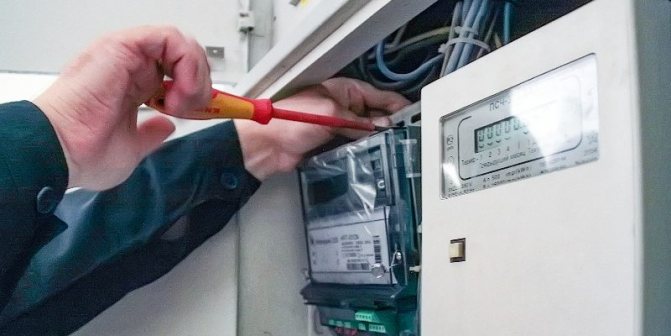
Primary
The subscriber has no direct relation to this type of verification of the electric meter. It is carried out at the manufacturing plant. This assessment of quality characteristics is carried out as soon as the product is finally completed and ready for shipment to the consumer.
Factory initial verification, carried out at an industrial manufacturing enterprise, makes it possible to qualifiedly determine the quality of operation of a specific unit from a series of metering devices.
All indicators that must comply with standards and certification conditions are included in the technical documentation. It accompanies the product and is handed over to the buyer in technical supermarkets. Data on the class and other important characteristics of metering devices included in the technical documentation are not subject to additional verification.
The law gives the right of primary technical control to the enterprise regardless of the metrology and standardization bodies. They can determine the suitability of the device for operation. However, there are some time restrictions. This is a legal requirement.
If the storage time of a product after its manufacture is more than 1 year, initial verification is not enough - periodic verification is carried out. The owner of the device will have to pay for it. This norm is also specified in the rules for electrical installations - the ABC of power engineers - PEU.
Periodic
Periodic verification is carried out at different times and depends on the type of metering device used. The usual period for periodic peer review is 8 years. A longer period is set for electronic versions of devices.
The time after how many years a periodic assessment of the quality of a metering device is carried out is established depending on the specific circumstances or the time of commissioning:
- new metering device - from the time of production (from the moment of factory packaging);
- installed device - from the moment of operation and recording of this information and indicators in the accounting documentation;
- for the device used - from the time of the previous verification.
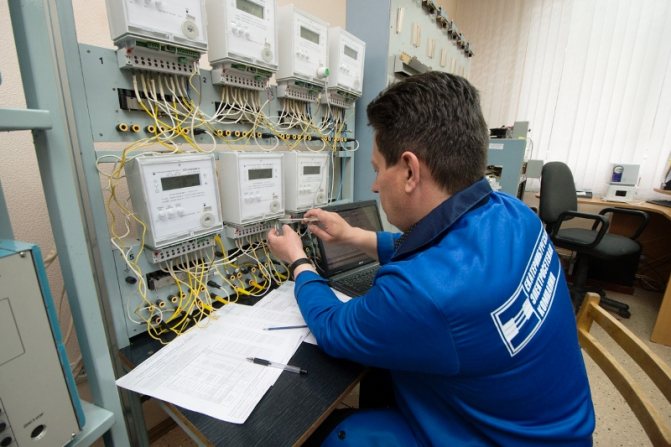
Extraordinary
Such verification of meters is carried out by the user himself or the controlling organization at any time when required. The reason for its implementation is the doubtfulness of the accuracy of measurements or obvious signs of distortion of the measured indicators.
In addition, this type of analysis of the quality of the meter’s operation is carried out if there are abnormal situations:
- documentation is lost and there is no way to clearly establish the date of the previous or initial verification;
- if the device has been repaired and it is necessary to check the quality of measurements;
- if a comprehensive replacement of equipment is being carried out and verification of metering indicators is required.

Electric meter verification procedure
The verification period for the electricity meter is controlled by the owner of the apartment or private house. The obligated citizen must independently agree on the date of transfer of the device for diagnostics and deliver the IPU to the address of the metrological center. However, at the legislative level, conducting verification without removal is an acceptable procedure if the contractor has accreditation.
Step No. 1: Analysis of the correct connection of the electric meter
The use of a control device depends on the type of IPU and the number of phases. On the diagram this can be reflected as two connected inputs - zero and phase, as well as the point of connection with the load circuit.
The controller can diagnose problems with the electric meter by identifying additional sources of connection to the network. In the second case, suspicion may be caused by a violation of the connection sequence.
Deviations from the norm are grounds for additional verification, since such cases often indicate theft of resources through unauthorized connection. The correctness of the connected individual energy consumption device is carried out by simple inspection.
Step #2: Self-propelled research
The concept of “self-propelled” meter means circumstances under which the device disk rotates without additional load, i.e., on its own and at the same time all electrical appliances are de-energized. After turning on all the diverter automation, the controller observes the movement of the mechanism for 7-10 minutes.
If the device is working properly, then rotation will not occur, and the indicator will not show more than one pulse. In the opposite situation and a flashing sensor, the procedure ends with re-verification or installation of a new IPU.
Step #3: Gear Ratio
The gear ratio is set on the external panel of the electric meter. The coefficient provides information to the consumer and the RSO about the number of revolutions or blinks - the type of reading depends on the type of device.
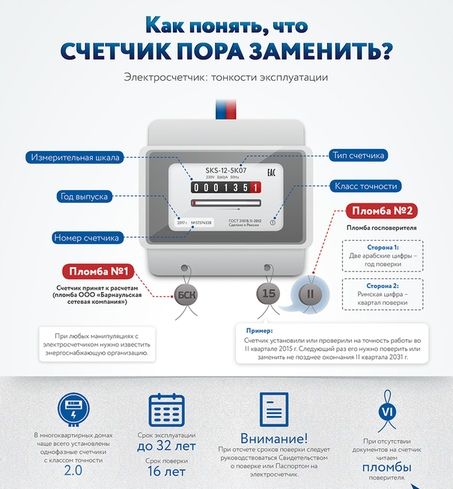
How to understand that it is time to replace the meter.
Based on the rotation of the disk or electronic indicator, the consumed resource is calculated. In other words, these figures act as indications for calculating electricity - 1 kilowatt is equal to the approved tariff in the region.
Step #4: Establishing the error
Another necessary stage of conducting an inter-interval check of the electric meter is error diagnosis. The event is conditioned by establishing the correctness of the transmitted readings.
Step #5. Detection of meter magnetization
A pressing question for consumers is how often the electric meter is checked for magnetization. The topic is of interest to those property owners who have an old-style disk device installed. The new generation of IPUs are created on the basis of induction and have a protective seal that changes color when interacting with a magnet. Verifications of this type are required by the RSO to be carried out no more than once every six months.
An analysis of the magnetization of an individual consumption device can be carried out using a regular needle - if it is attracted to the equipment, then, therefore, the IPU has a strong magnetic field. It is noteworthy that such circumstances work both to the consumer’s advantage and to the disadvantage. That is, prohibited devices will not slow down, but, on the contrary, will accelerate the rotation of the disk, which means the owner will pay more.
Verification period
The timing of verification of electricity meters depends on the specifics of the procedure, i.e. whether the IPU needs to be removed or not. In the first case, a thorough diagnosis and issuance of a result on the possibility of operation will be required. This procedure can take several hours or 2-3 days.
If the inter-verification analysis does not require dismantling the electric meter, then the defining parameters are:
- diagnostics of the nominal voltage in the network - takes about 15-20 minutes;
- checking the fact of “self-propelled” – this will take 10-20 minutes;
- 10 min. an inspection is performed to ensure that there are no physical defects on the IPU;
- additional time is spent completing the report on a special form and sealing the meter.
What documents are issued after verification - types of marks in the act
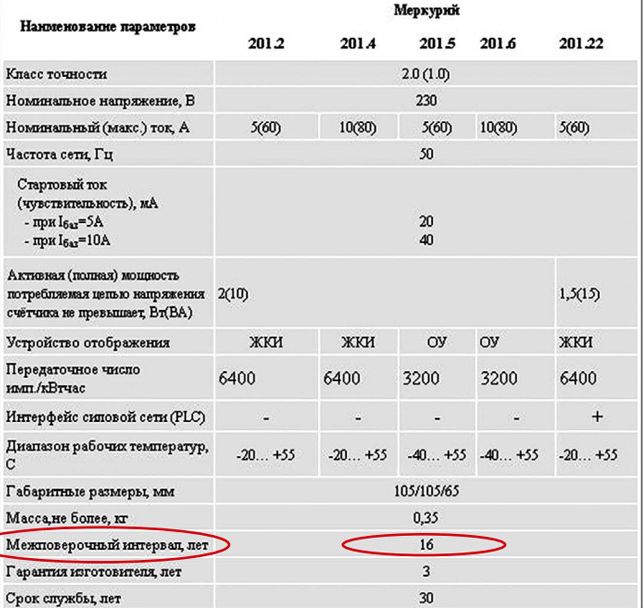
Calibration interval of the Mercury meter.
If the verification interval of the electric meter expires, then it is necessary to submit an application to the state metrological center or a private company. In the document about the certified device, the employee of the institution is obliged to put notes not only about the fact of diagnostics, but also to reflect the dismantling and installation of the IPU.
According to regulatory provisions, legal removal of the device is carried out by RSO employees.
An employee of the institution is authorized to carry out the following activities:
- Comparative analysis of current electric meter readings.
- Preparation of documents for dismantling IPU.
- Initiate the transfer of settlement transactions from the amount of consumed resources according to average standards.
Removal and installation of equipment is also carried out by employees of an energy-saving institution. After installation of the resource metering device, sealing is carried out. Such operations are permitted by accredited persons. Violation of the control label is subject to administrative penalties.
After replacing the IPU, if necessary, an act is generated. The document is endorsed by two parties - the owner of the premises and the contractor.
The paper must be drawn up reflecting the following information:
- address of the property where the work was carried out;
- technical parameters of the removed and installed device;
- date of procedure;
- the day of verification of old and new equipment;
- indications;
- the number of unaccounted resources at the time of the absence of the IPU;
- reasons for replacement;
- data of the company that carried out the maintenance of the electric meter, including details.
In case of installation of a new individual metering device, it is necessary to draw up an act in two copies. One copy remains with the apartment owner, the second is transferred to the RSO. If only verification was carried out, then the date is stamped on the seal and is additionally displayed in the technical passport. The next verification interval will be counted from this day.
According to current laws, an employee of the organization must also reflect in the documents the identified shortcomings and errors in the transmitted readings. Correct operation of the equipment depends on the type of device being used and ranges from 6 to 16 years.
What to do if the verification period has expired
If the verification period for your electrical energy meter has expired, this does not mean that it needs to be replaced with a new one. First, find out what accuracy class it has. Based on this, determine whether it is possible to verify it.
If your device has an accuracy class of 2.5, then it will have to be replaced. But send devices of accuracy classes 2 or 1 for verification. When the verification procedure is completed and you are given the corresponding certificate, provide it to the electricity supply company.
After the fact of your verification is recorded, the electricity supply company will make charges based on the readings of your electrical energy meter, and not according to the established standard.
It is necessary to independently monitor the verification period for the electrical energy meter you own, since electricity supply companies do not always send relevant notifications in a timely manner.
It is unacceptable to carry out the procedure for dismantling and installing electrical energy metering devices without the participation of representatives of the electricity supply company.
A timely implementation of the procedure for checking the electrical energy meter will allow you to avoid many problems in your relationship with the electricity supply company.
Who pays and the cost of checking the electricity meter
The owner of the property independently bears the burden of expenses for servicing the electric meter.
This applies to the following activities:
- dismantling;
- transportation;
- diagnostics;
- installation;
- installation of a seal.
The cost of checking the electric meter will depend on its type and model.
The table shows the estimated cost of the service:
Table 3.
| Service name | Cost, rubles |
| Induction single-phase devices | 600-800 |
| Verification of a similar device, but electronic | 700-900 |
| Three-phase energy metering equipment | |
| Mechanical | 800-1000 |
| Electronic | 850-950 |
| Current prices should be obtained from organizations that verify electricity meters. | |
It is noteworthy that private companies offer additional services so that the consumer does not overstay the verification interval.
For example:
- diagnostics within 5 days leads to an average price increase of 20%;
- if similar work needs to be completed in 3 working days, then by 50%;
- high urgency of the event leads to the establishment of a premium of 100%.
Free verification
Free verification is available to citizens who have entered into a social tenancy agreement or to users of municipal housing.
Calibration interval
The allowed period of operation of the meter from one verification to another is called the inter-verification interval.
Each type or model of meter has its own interval; its duration is indicated by the manufacturer in the passport.
In general, the calibration interval can range from 4 to 16 years , depending on the type of device.
During verification, the meter body is sealed with a special seal, which indicates the year and quarter of the verification, so that the next date can be determined.
In addition, a mark is placed in the technical passport of the device or a verification certificate .
What to do if the MPI has expired
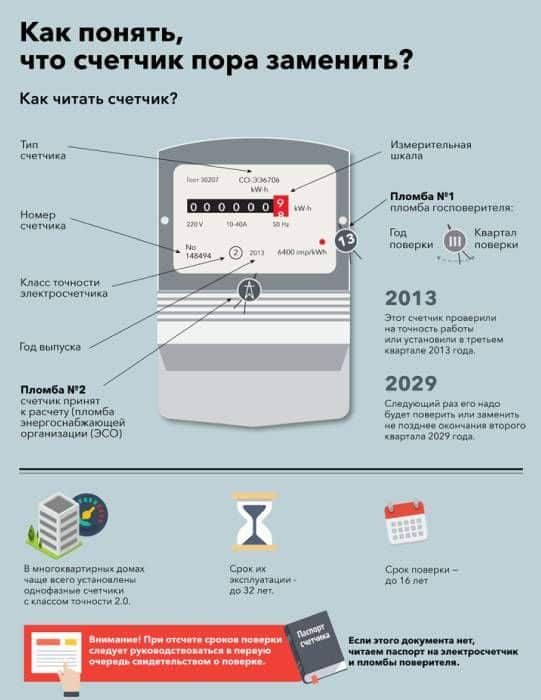
How to understand that the meter needs to be replaced.
If your electricity meter has expired, you need to contact your utility service provider. A written notification is drawn up about the need to diagnose IPU. During device research, fees for resource consumption will be charged based on average indicators.
If the IPU is not verified and installation is not carried out within 3 months, then receipts will be issued in accordance with the standards relevant in the consumer’s region of residence. Each subject of the Russian Federation has separate regulations for such cases. Experts recommend purchasing a new sealed electric meter, since in most situations, after diagnostics, the non-working state of the old IPU becomes clear.


